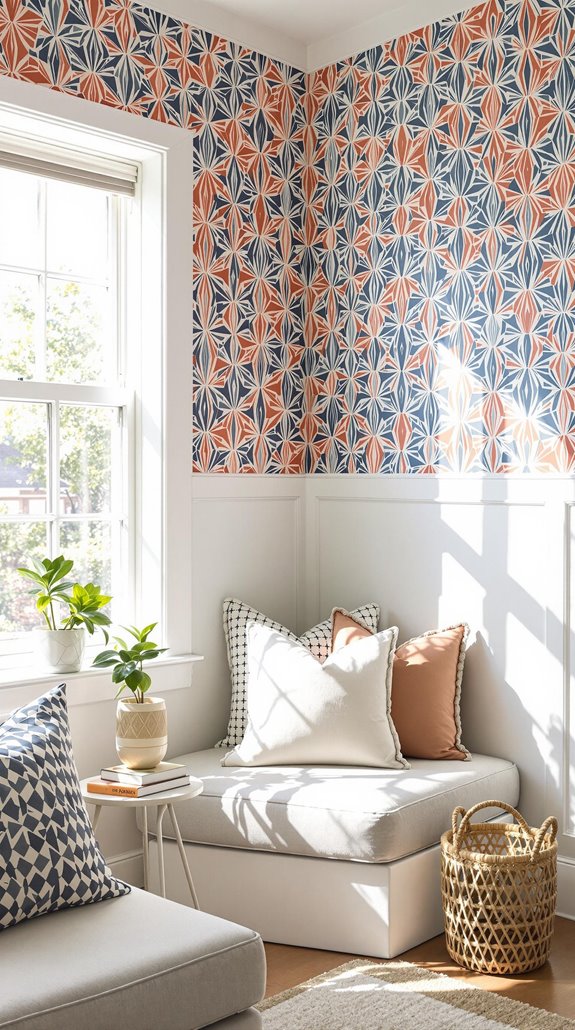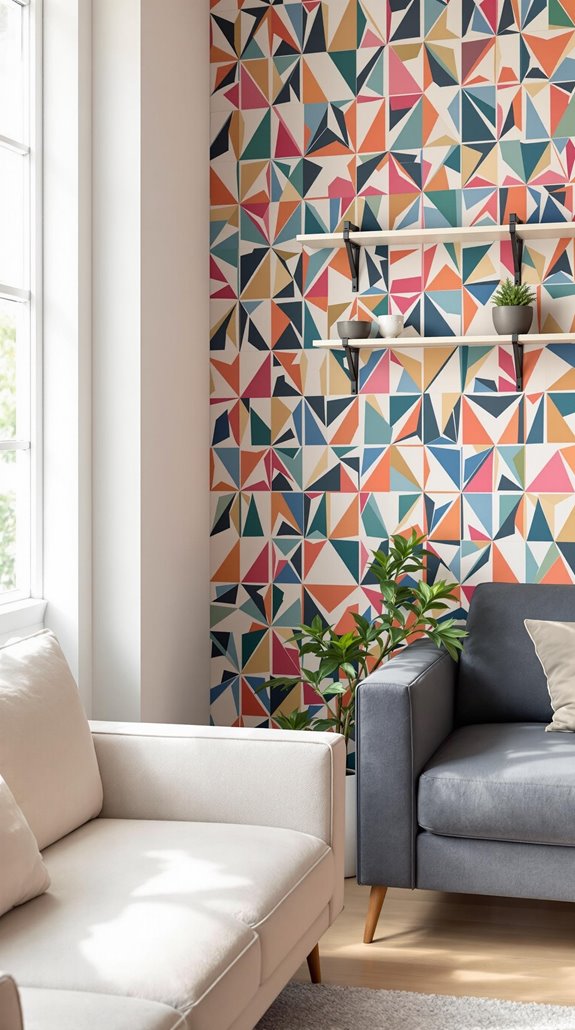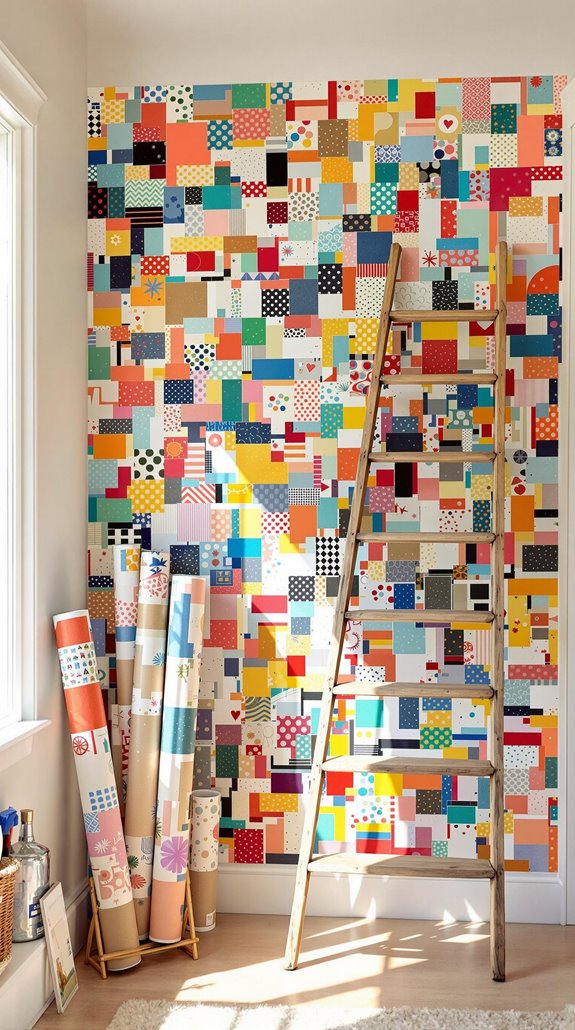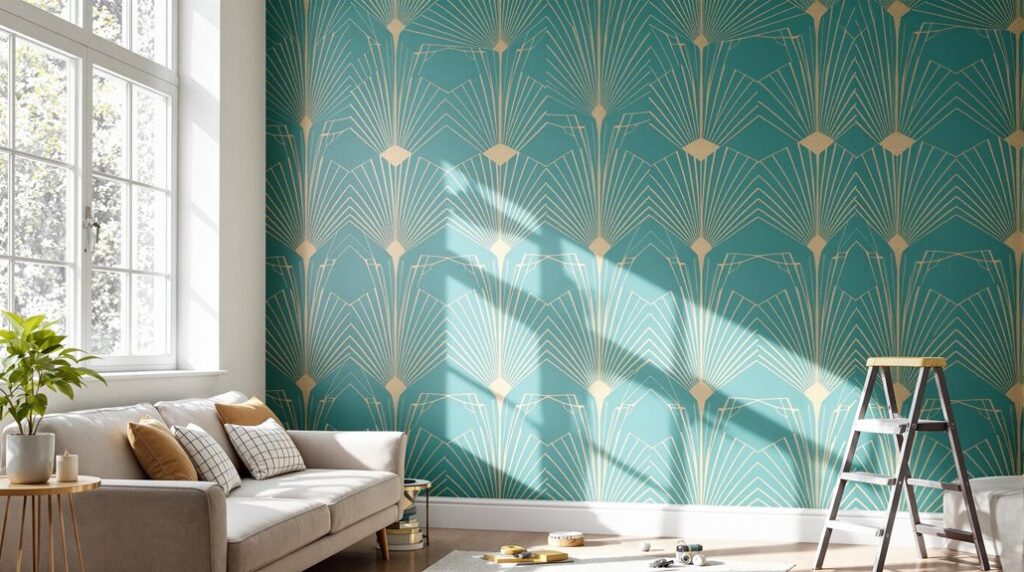I’ve discovered that transforming your walls doesn’t require a designer budget or professional installation. You can achieve stunning results with strategic wallpaper placement, smart shopping techniques, and clever DIY methods that cost a fraction of traditional renovations. I’ll show you exactly where to find the best deals, which materials work best for different projects, and how to maximize impact with minimal investment. The key lies in understanding one essential difference between installation approaches.
Key Takeaways
- Choose peel-and-stick wallpaper to eliminate paste and professional installation costs, reducing project expenses by up to 50%.
- Create accent walls instead of full room coverage to maximize visual impact while using minimal material and budget.
- Shop clearance sections and time purchases during major holidays for discounts of 30-60% off regular prices.
- Apply wallpaper to small spaces like stair risers, bookshelf backs, or cabinet interiors for high-impact transformations with minimal cost.
- Repurpose leftover wallpaper remnants on furniture surfaces, drawer interiors, and mirror frames to maximize your investment.
Finding the Best Deals: Where to Shop for Affordable Wallpaper
When you’re hunting for affordable wallpaper, knowing where to shop can slash your decorating budget in half. I’ve discovered that outlet sections are goldmines for budget-conscious decorators like us.
Start with Brewster Wallcovering’s discount remnant section – you’ll find trending styles at unbelievable prices, plus free shipping over $100. Their remnants offer the same quality as full-price rolls but at a fraction of the cost.
Next, check Walls Republic’s outlet section where rolls start at just $24. While clearance items are final sale, the savings are substantial enough to justify the risk. For larger projects, take advantage of their free shipping on orders over $250 to maximize your budget.
Don’t overlook World of Wallpaper’s 322 sale items with exclusive discounts reaching 40% off. I filter these by price to find the best deals quickly, making budget decorating achievable for everyone.
Peel-And-Stick Vs Traditional: Why Removable Wallpaper Wins for Budget Projects
Although traditional wallpaper has dominated home décor for decades, peel-and-stick wallpaper delivers unmatched budget advantages that’ll transform your decorating approach. I’ve discovered it cuts project expenses by up to 50% since you won’t need paste, primers, or professional installers. You’ll save money on materials too—peel-and-stick costs less per square foot and lets you create stunning accent walls instead of covering entire rooms.
Here’s what makes it budget-friendly: repositioning during installation prevents costly mistakes, damaged sections replace individually, and removal requires zero wall repairs. The low-tack adhesive means you can easily reposition the wallpaper during installation if you make a mistake, saving both time and materials. Additionally, using peel-and-stick wallpaper can minimize hidden costs associated with traditional renovation methods, making it a savvy choice for budget-conscious decorators. While traditional wallpaper lasts longer, peel-and-stick’s 3-5 year lifespan perfectly matches our fast-changing design preferences. You’ll join countless decorators who’ve embraced this cost-effective solution for rental properties and temporary updates.
Creative Placement Ideas That Maximize Impact While Minimizing Cost

Smart placement strategies can triple your wallpaper’s visual impact without expanding your budget. I’ve discovered that targeting specific architectural elements creates maximum drama with minimal material.
Start with stair risers—they’re small surfaces that deliver big visual punch. You’ll use just a few strips but create stunning focal points guests notice immediately. Next, try the backs of built-in bookshelves. This technique adds depth and sophistication while requiring minimal wallpaper. Incorporating effective planning can further enhance your overall design strategy.
Wainscoting applications work brilliantly too. Apply wallpaper above traditional wainscoting for updated elegance that feels custom-designed.
For unexpected spaces, line closet interiors or apply wallpaper under bathroom sinks. These surprise elements feel luxurious while using leftover scraps. Cabinet backs offer another high-impact, low-cost option that transforms ordinary storage into designer features. When installing in tight spaces, keep a straight edge tool handy to press out bubbles and ensure smooth application around corners.
Alternative Materials and Budget-Friendly Wallpaper Substitutes
Why spend hundreds on designer wallpaper when creative alternatives deliver the same visual impact for pennies on the dollar? I’ve discovered game-changing substitutes that’ll transform your space without breaking the bank.
Removable wallpaper like Chasing Paper offers poly-woven fabric covering 24 square feet per roll, allowing repositioning and damage-free removal. For even less, I use fabric with tension rods or removable adhesives – tapestries create stunning focal points while geometric patterns add modern flair. Current UK trends emphasize the use of bold colors and patterns, making these alternatives even more appealing.
Paper-based solutions work brilliantly too. Vintage book pages, old maps, or dollar store gift wrap create unique feature walls using painters tape and double-sided tape. Wood-patterned bulletin board paper mimics expensive planks at craft store prices. When selecting patterns, remember that small patterns work better for compact spaces while larger designs suit bigger rooms.
My favorite hack? DIY murals using stencils and paint cost a fraction of wallpaper while delivering personalized results that perfectly match your style.
Money-Saving Installation Techniques and DIY Methods
When you tackle wallpaper installation yourself, you’ll cut costs by 60-80% compared to hiring professionals – and it’s easier than you think with the right approach. I’ll share the game-changing techniques that transform beginners into confident installers.
Start with paste-the-wall wallpaper – it eliminates messy pasting and speeds up application. Clean your walls with a damp cloth, then mark straight vertical lines using a basic 48-inch level. Cut strips several inches longer than wall height for adjustment room.
Use a paint roller to apply paste evenly, and work directly from the roll to minimize waste. For outlets, apply wallpaper loosely, pierce the center, then cut outward. Overlap seams slightly and press with a seam roller for professional-looking results without the professional price tag. Order wallpaper samples first to test your chosen design in your actual lighting conditions before committing to full rolls.
Understanding Wallpaper Pricing: From Discount to Designer Options
Before you choose your wallpaper, you’ll need to understand how pricing works across different quality tiers – because the difference between a $30 roll and a $300 roll isn’t just about the price tag.
I’ll break down the four main categories you’ll encounter. Budget options under $1 per square foot work perfectly for temporary projects or rental-friendly changes. Mid-range vinyl papers ($2-5 per sq ft) offer the sweet spot between durability and design variety. Premium collections ($5-25 per sq ft) feature intricate patterns and luxury materials that’ll last decades.
Here’s what drives costs: material type, pattern complexity, and installation requirements. Complex patterns create 10-30% waste during installation, while high-end grasscloth demands professional handling. Shop clearance sections for designer patterns at 30-60% discounts. Many quality wallpapers have regular prices averaging around $203.73, with significant savings available during sales.
Small Space Solutions: Getting Big Results With Minimal Material

Now that you know what you’ll spend, let’s maximize your wallpaper investment in smaller rooms where every square foot counts. I’ll show you how to create stunning transformations using strategic placement and smart material choices.
Start with a single accent wall—you’ll use minimal material while achieving maximum visual impact. Choose oversized motifs or vertical stripes to trick the eye into perceiving more space and height. For narrow hallways, vertical patterns create that essential ceiling height illusion. Incorporating budget-friendly tips can also enhance the overall look without breaking the bank.
Match your trim to the wallpaper tones to unify the space and add depth. In windowless areas like powder rooms, embrace dark-toned designs for cozy atmosphere. Consider peel-and-stick options to reduce waste during future updates, and always test samples to prevent costly color-matching errors between batches.
Look for wallpapers with hand-painted brushstrokes to add authentic texture and artisan character to your space without the expense of custom artwork.
Seasonal Sales and Timing Your Wallpaper Purchase
Since wallpaper represents a significant investment in your home’s aesthetics, timing your purchase strategically can slash costs by 30-60% without compromising on quality or style.
I’ve discovered that monitoring major holidays like Black Friday and Cyber Monday delivers the deepest discounts. You’ll find end-of-season clearances in January and July when retailers dump outgoing designs for new trends. Sign up for brand newsletters to access exclusive promo codes and early sales.
Target inventory liquidations after design fairs when brands shift collections. Use price-tracking tools to identify discount patterns for your favorite styles. Capitalize on Memorial Day, Labor Day, and Fourth of July sitewide sales. Many retailers also offer sample sales that provide access to unique designer pieces at dramatically reduced prices. Purchase discontinued patterns when new collections launch – you’ll score premium designs at clearance prices while everyone else pays full retail.
Repurposing and Upcycling: Making the Most of Leftover Materials

After completing your wallpaper project, you’ll inevitably face rolls of leftover material that represent untapped potential for creative home improvements. I’ve discovered that transforming old furniture with wallpaper remnants creates cohesive room aesthetics while maximizing your investment.
Start by covering cabinet doors, drawers, and tabletops using standard wallpaper paste. For high-use surfaces like wardrobes, I recommend non-woven wallpaper for durability. Always treat both sides of wooden surfaces to prevent warping from paste absorption. Before applying wallpaper to wooden or plastic furniture, sand down surfaces to create better adhesion for the paste. Additionally, ensure that you have essential tools ready to make the process smoother and more efficient.
Don’t overlook smaller projects—cut-offs work perfectly for mirror frames or trash cans. Try decoupage techniques on backsplashes for waterproof, wipeable surfaces, or line drawer interiors for hidden decorative accents. Combine mismatched scraps into mosaic-style designs on furniture fronts, creating unique pieces that reflect your personal style.
Conclusion
I’ve shown you nine practical strategies to transform your walls without overspending. Start by hunting for deals at discount retailers, then choose peel-and-stick options for easy installation. Focus on high-impact areas like accent walls, experiment with alternative materials, and time your purchases around seasonal sales. Don’t forget to save every scrap for future projects. With these budget-friendly techniques, you’ll create stunning wall transformations that look expensive but won’t drain your wallet.
References
- https://athomewithashley.com/affordable-wallpaper/
- https://abeautifulmess.com/super-affordable-diy-wallpaper-hack/
- https://www.wallhub.com.sg/5-best-budget-friendly-wallpaper-ideas-for-every-room/
- https://www.coohom.com/article/understanding-wallpaper-rates-a-comprehensive-guide
- https://www.mybespokeroom.com/inspiration/budget-friendly-wallpaper-ideas
- https://wallsrepublic.com/collections/wallpaper-outlet
- https://www.worldofwallpaper.com/us/sale-offers.html
- https://www.wallpaperdirect.com/us
- http://www.brewsterwallcovering.com/discount-wallpaper
- https://www.wallpaperstogo.com

